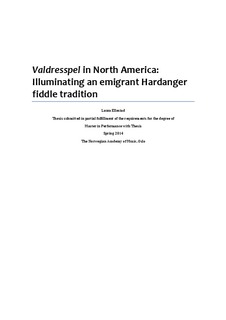| dc.description.abstract | This paper will attempt to examine and interpret the music and activities of five of the foremost emigrant Hardanger fiddlers from the Valdres district in Norway: Arne Steinsrud (1799-‐1878), Bendik i Nø’n (1827-‐1882), Knut Sjåheim (1849-‐1908), Trond Eltun (1823-‐1896), and Oscar Hamrey (1884-‐1943). All five fiddlers emigrated to North America during the Norwegian migration period, an era spanning from approximately 1825 to 1925. In my bachelor’s thesis, I concluded that approximately 60 Hardanger fiddle players emigrated to North America from Valdres during the main period of Norwegian emigration to North America.1 The five aforementioned fiddlers were all important bearers of the Hardanger fiddle tradition from Valdres (a tradition I have chosen to call valdresspel), and each of them found unique and innovative ways to share their music in their new homeland. By examining their music and activities in America, I hope to gain an understanding of their repertoires, playing styles, and musical lives, and further to interpret and present this folk music tradition through performance practice. Relevant historical background information is introduced in chapter two, including short discussions about Norwegian emigration to North America, the folk music milieu among Norwegian immigrants, and the Hardanger fiddle tradition in Valdres. Chapters three to eight present comprehensive investigations of the five fiddlers, with one chapter devoted to each fiddler. Since the date of each fiddler’s arrival in North America seems to have been the strongest factor in determining the kinds of performance opportunities that were available, the chapters have been arranged chronologically according to the year of the fiddlers’ emigration. The same structure is employed in each chapter: first, a biographical sketch is given, followed by a review of the fiddler’s teachers, students, and playing style, and an examination of the fiddler’s lifestyle and activities in North America. This is succeeded by an investigation of the fiddler’s repertoire, in which relevant source materials, known repertoire, and selected tunes are discussed. Finally, my own reflections from the process of interpreting repertoire connected to each fiddler are presented. At the ends of chapters four and five, I also present details from my interviews with Håkon Asheim and Vidar Lande. Repertoire lists, “tradition maps,” and transcriptions connected to each fiddler are included in chapter 10 (Appendix). A CD recording of my interpretations of 14 tunes from this project can be found at the end of the paper. | nb_NO |
